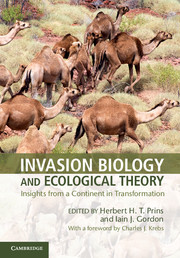Book contents
- Frontmatter
- Contents
- List of Contributors
- Foreword
- 1 Testing hypotheses about biological invasions and Charles Darwin’s two-creators rumination
- Part I Ancient invaders
- Part II Modern invaders
- 13 Invasion by woody shrubs and trees
- 14 Modern tree colonisers from Australia into the rest of the world
- 15 Failed introductions: finches from outside Australia
- 16 The skylark
- 17 Why northern hemisphere waders did not colonise the south
- 18 Weak migratory interchange by birds between Australia and Asia
- 19 Introducing a new top predator, the dingo
- 20 The European rabbit
- 21 The rise and fall of the Asian water buffalo in the monsoonal tropics of northern Australia
- 22 A critique of ecological theory and a salute to natural history
- Index
- References
20 - The European rabbit
Australia’s worst mammalian invader
from Part II - Modern invaders
Published online by Cambridge University Press: 05 February 2014
- Frontmatter
- Contents
- List of Contributors
- Foreword
- 1 Testing hypotheses about biological invasions and Charles Darwin’s two-creators rumination
- Part I Ancient invaders
- Part II Modern invaders
- 13 Invasion by woody shrubs and trees
- 14 Modern tree colonisers from Australia into the rest of the world
- 15 Failed introductions: finches from outside Australia
- 16 The skylark
- 17 Why northern hemisphere waders did not colonise the south
- 18 Weak migratory interchange by birds between Australia and Asia
- 19 Introducing a new top predator, the dingo
- 20 The European rabbit
- 21 The rise and fall of the Asian water buffalo in the monsoonal tropics of northern Australia
- 22 A critique of ecological theory and a salute to natural history
- Index
- References
Summary
Introduction
Introductions of many plants and animals began with the first human settlements in Australia and continued for many decades. Acclimatisation societies enthusiastically introduced birds, mammals and plants to reshape the land for aesthetic reasons and also for recreation (Dunlap 1997). Introduced animals have been a major factor in Australia’s unenviable record of having nearly half the known mammalian extinctions worldwide in the past 200 years (Short and Smith 1994). In this chapter we describe the arrival and establishment of an alien invasive species, the European rabbit Oryctolagus cuniculus L. in Australia and the likely reasons for their successful establishment.
Australia’s record of ‘achievement’ for successfully releasing alien invasive mammalian pests is disheartening. Cattle were perhaps the first of the invaders, after arriving with the first European settlers in 1788. Domestic cattle strayed into the wilderness and had increased tenfold by the time they were discovered in 1795 (Rolls 1969). Over the next 200 years there were 79 subsequent releases of introduced mammalian species, 54 of which are known to or likely to have established (Long, 2003). Original releases occurred by accident, as was the case with escaping domestic animals, or were deliberate for reasons ranging from acclimatisation, subjects of the hunt, sources of food or fur, or in some cases as biological control agents (Rolls 1969). At least 15 mammals now have widespread distributions on the mainland with some associated pest status (Bomford and Hart 2002). The Australian Vertebrate Pests Committee (VPC) has nominated seven of these mammals as nationally significant invasive animals: feral pigs (Sus scrofa L.), feral goats (Capra hircus L.), rabbits (O. cuniculus), foxes (Vulpes vulpes L.), feral cats (Felis catus L.), wild dogs (including dingo hybrids) (Canis lupus familiaris L. and Canis lupus dingo Meyer) and feral deer (various species) (National Land and Water Resources Audit 2008).
- Type
- Chapter
- Information
- Invasion Biology and Ecological TheoryInsights from a Continent in Transformation, pp. 429 - 451Publisher: Cambridge University PressPrint publication year: 2014
References
- 3
- Cited by

